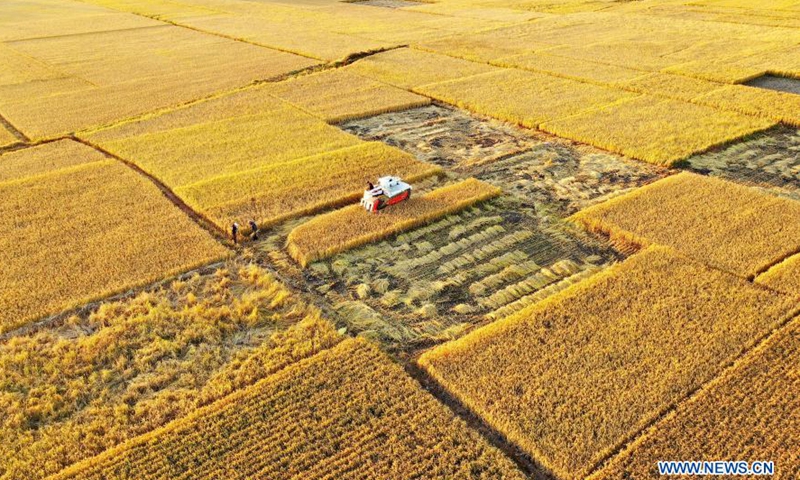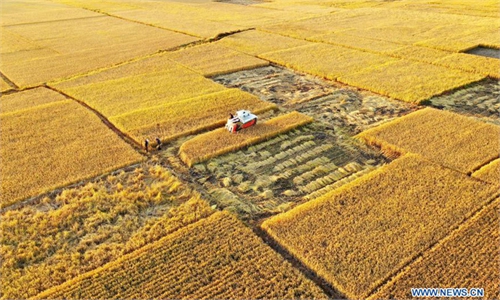China says grain reserve abundant, processing ability remains strong during holiday season

Aerial photo taken on Oct. 18, 2020 shows harvesters operating in rice fields at Jiangzhuang Village of Luanzhou City in north China's Hebei Province. China's grain output reached nearly 670 billion kg in 2020, up 5.65 billion kg, or 0.9 percent, from last year, the National Bureau of Statistics (NBS) said on Thursday. This marks the sixth consecutive year that the country's total grain production has exceeded 650 billion kg. The bumper harvest comes despite disrupted farming as a result of the COVID-19 epidemic, which has been held in check thanks to efforts to ensure the transportation of agricultural materials and strengthen farming management.Photo:Xinhua
China reiterated on Thursday that there's no need to hoard grains during the upcoming Spring Festival as reserves are abundant and processing ability remains strong, saying that holiday demand can be fully ensured.
China's rice and wheat inventories are at a relatively high level and can meet one-year demand. Major cities have established grain and oil reserves to meet local demand for more than 15 days, Qin Yuyun, head of grain reserves at the National Food and Strategic Reserves Administration, told a press conference held in Beijing on Thursday.
Grain and oil processing capacity is strong. At present, more than 20,000 enterprises included in the statistics can process 1.5 million tons of rice and 800,000 tons of wheat every day, according to Qin.
Take North China's Hebei Province as an example, it can process 52,000 tons of flour and 5,000 tons of rice per day, which is enough for urban and rural residents in the province to eat for 3 days, said the official.
The administration also disclosed that China imported 11.32 million tons of wheat and rice in 2020, though has increased compared with 2019, only accounted for 3 percent of its total output, noting that the imports were not due to domestic supply shortage, but for advantages in price or quality.
Moreover, as China has continuously promoted the soybean revitalization plan, domestic soybean planting area has increased for five consecutive years. According to data from the National Bureau of Statistics, China's soybean planting area reached 148 million mu (9.9 million hectares) in 2020, an increase of 5.9 percent year-on-year.
However, due to the recent epidemics in Northeast China's Heilongjiang and Jilin provinces, soybean purchases and transports have been affected, thus it is expected that soybean prices will remain at a relatively high level in the later period, Wang Xiaohui, chief analyst of the China National Grain and Oils Information Center, said at the press conference on Thursday.


